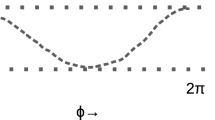Abstract
For the potentialV(R)=CR −4(1+ε(cos2ϑ−1/2)) and a planar geometry we compute classical trajectories, which are a good approximation to those trapped orbits which separate collisions with “capture” from those without. Two possible types of such trajectories (rotating or librating in the rotating reference frame) and the transition between both types are discussed. From the limiting impact parameters accurate capture cross sections may be calculated. They can be compared with the popular approximation known as ADO — (average dipole orientation) — theory, but an analysis of the latter shows that it is theoretically not justified. Instead, the adiabatic approximation for planar collisions is developed with and without angular momentum conservation. It fits numerical calculations very well as long as the transition from rotation to libration lies inside the centrifugal wall, i.e. the separating orbit is a rotation. In the opposite case only qualitative agreement is obtained. Finally, a simple approximation to get 3D capture cross sections from planar calculations is discussed.
Similar content being viewed by others
References
Langevin, P.: Ann. Chim. Phys.5, 245 (1905)
Gioumousis, G., Stevenson, D.P.: J. Chem. Phys.29, 294 (1958)
Henchman, M.J.: In: Ion-molecule reactions. Franklin, J.L. (ed.), Vol. 1. London: Butterworths 1972
Su, T., Bowers, M.T.: In: Gas phase ion chemistry. Bowers, M.T. (ed.), Vol. 1. New York: Academic Press 1979
Pechukas, P., Pollak, E.: J. Chem. Phys.67, 5976 (1977)
Pollak, E., Pechukas, P.: J. Chem. Phys.69, 1218 (1978)
Pollak, E., Child, M., Pechukas, P.: J. Chem. Phys.72, 1669 (1980)
Pechukas, P.: J. Chem. Phys.73, 993 (1980)
Pollak, E.: Chem. Phys. Lett.91, 27 (1982)
Dugan, J.V., Magee, J.L.: J. Chem. Phys.47, 3103 (1967)
Dugan, J.V.: Chem. Phys. Lett.8, 198 (1970)
Dugan, J.V., Palmer, R.W.: Chem. Phys. Lett.13, 144 (1971)
Dugan, J.V., Canright, R.B.: J. Chem. Phys.56, 3623 (1971)
Dugan, J.V.: Chem. Phys. Lett.21, 476 (1973)
Chesnavich, W.J., Su, T., Bowers, M.T.: J. Chem. Phys.72, 2641 (1980)
Su, T., Chesnavich, W.J.: J. Chem. Phys.76, 5183 (1982)
Su, T.: J. Chem. Phys.82, 2164 (1985)
Hsieh, E.T., Castleman, A.W., Upschulte, B.L.: Announced in Ref. 18
Rynefors, K., Marković, N.: Chem. Phys.92, 327 (1985)
Moran, T.F., Hamill, W.H.: J. Chem. Phys.39, 1413 (1963)
Hsieh, E.T., Castleman, A.W.: Int. J. Mass Spectrosc. Ion Phys.40, 295 (1981)
Su, T., Bowers, M.T.: J. Chem. Phys.58, 3027 (1973)
Su, T., Bowers, M.T.: Int. J. Mass Spectrosc. Ion Phys.25, 1 (1975)
Bass, L., Su, T., Bowers, M.T.: Int. J. Mass Spectrosc. Ion Phys.28, 389 (1978)
Bates, D.: Chem. Phys. Lett.82, 396 (1981)
Bates, D.: Proc. R. Soc. London Ser. A384, 289 (1982)
Bates, D.: Chem. Phys. Lett.97, 19 (1983)
Takayanagi, K.: J. Phys. Soc. Jpn.45, 976 (1978)
Sakimoto, K.: J. Phys. Soc. Jpn.48, 1683 (1980)
Sakimoto, K., Takayanagi, K.: J. Phys. Soc. Jpn.48, 2076 (1980)
Gerlich, D., Nowotny, U., Schlier, Ch., Teloy, E.: Chem. Phys.47, 245 (1980)
Pollak, E.: Chem. Phys.61, 305 (1981)
Goldstein, H.: Classical mechanics. Reading: Addison Wesley 1980, 11–7
Abramowitz, M., Stegun, I.A.: Handbook of mathematical functions. NBS Applied Mathematical Series 55. Washington D.C. 1964
Jahnke-Emde: Tables of higher functions. Emde, F. (ed.). Leipzig: Teubner (1948)
Pauling, L.: Phys. Rev.27, 568 (1926)
Mensing, L., Pauli, W.: Phys. Z.27, 509 (1928)
Manneback, C.: Phys. Z.27, 563 (1926)
Clary, D.C.: Mol. Phys.53, 3 (1984);54, 605 (1985)




